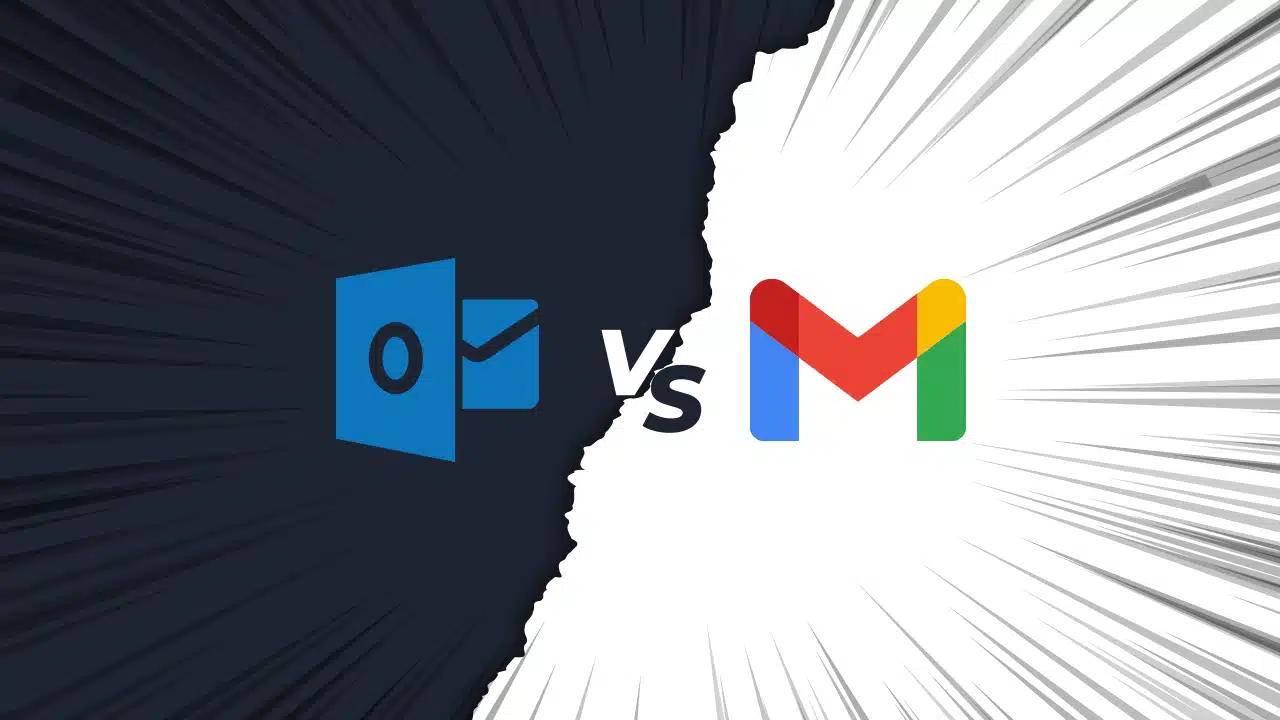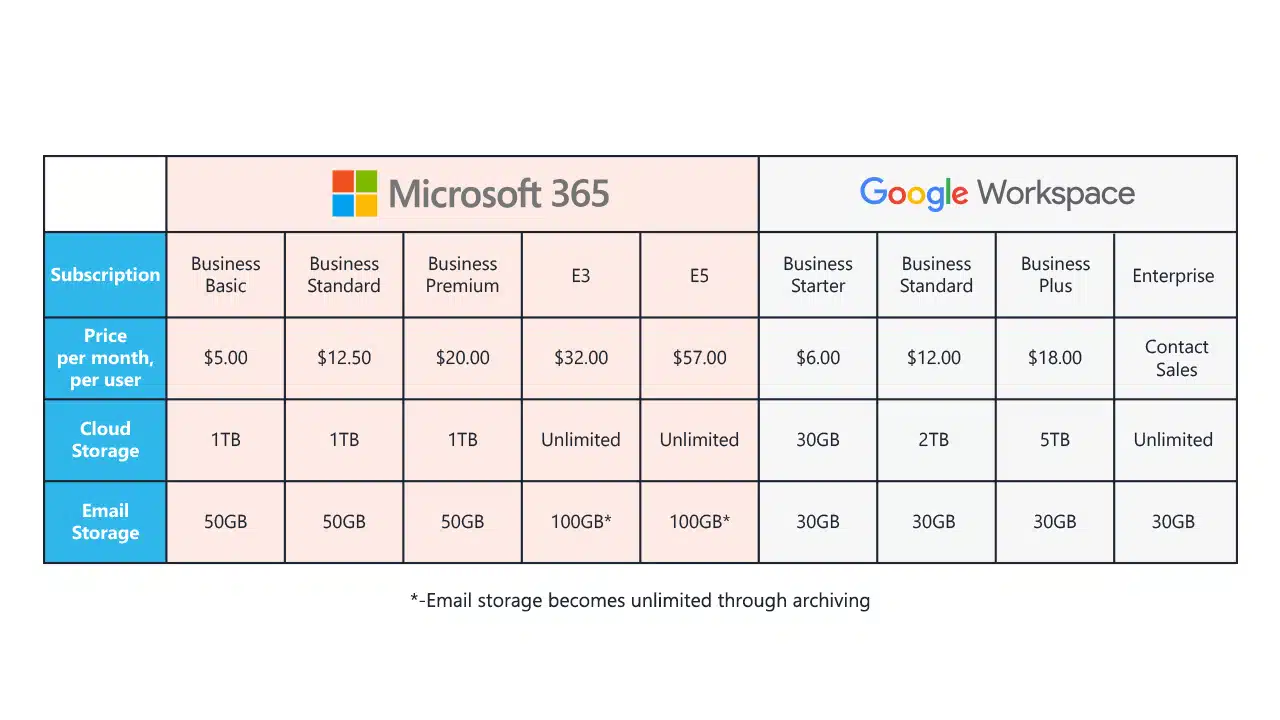Microsoft 365 and Google Workspace are the dominant productivity suites in the world of software as a service (SaaS), both offering a wide range of applications that modern companies need.
While the functions of many of these applications are similar, Microsoft and Google’s proprietary offerings each have their own quirks, for better or worse.
In this post, we will look at email through Microsoft Outlook and Google’s Gmail for Business. Independently, the pair are the leading email applications in business by market share and are pillars of M365 and Workspace, respectively.
Email may seem simple on the surface, but the differences between Outlook and Gmail show that things are more complicated than sending and receiving mail.
The workings of each are different, starting with how they are accessed, and ending with the security and privacy provided.
Pricing
Microsoft 365 and Google Workspace are priced per month, per user, and have different tiers of pricing. As it pertains to the mail accounts themselves, the difference in tiers generally only affects storage space.
Using Microsoft’s Business Basic plan ($5/month/user when billed annually), each user gets 50 GB of email storage space, which is independent of the additional 1 TB of cloud storage in OneDrive.
Keep in mind, the most basic level of M365 does not include any of Microsoft’s desktop applications, including Outlook. Users purchasing this plan will have to be happy with the Outlook web app.
Meanwhile, Google’s Business Basic plan ($6), provides just 30 GB of storage overall, combining email storage and drive storage together.
That’s right, 60% of the mailbox storage provided for Microsoft accounts for 100% of your total storage on Google’s cheapest plan.
That discrepancy is likely an attempt by Google to upsell users to their premium plans, with their Standard plan ($12) jumping to 2 TB of drive storage, and the Plus plan ($18) going to 5 TB.
Microsoft provides 2-5 TB of drive storage with their enterprise offerings, but mailbox storage can essentially be endless through unlimited archiving starting with the E3 plan ($32).
Scoring round 1 here, let’s call it a draw. At the cheapest level, the two platforms are similar, and Gmail’s web app could be worth the extra dollar per month.
As you move up plans, the Outlook desktop app could swing your decision, as we will discuss later. Keep in mind, Microsoft’s pricing is based on an annual commitment, while Google does not offer annual discounts as of this post.
This post is simply covering the two suites through the scope of their email applications, and these prices cover many other features. If price is your main factor, consider each suite in total before making a decision.
Ease of Use
The biggest difference between the two suites overall is Microsoft’s desktop apps, which are far more feature-packed relative to Google’s web apps.
While the features are not as different between the email applications, the full Gmail experience is only accessible through a web browser.
With Outlook’s desktop app, users get the full Exchange server experience, with the added benefit of being able to read and draft emails while offline.
For example, if you are on an airplane, replying to emails and working on documents you plan to send later may be the best use of your time.
With Outlook, you don’t need to wait for the internet to continue working, only to deliver your work.
Gmail’s interface can’t be reached without internet connectivity unless you first jump through some hoops.
At the time of this writing, you will need to use Google’s Chrome browser, have Gmail bookmarked, and sync your email via their offline feature, the reliability of which has been debatable over the years.
Both have mobile applications, so that issue can be worked around, but responding to a bevy of work emails on a mobile device can be a struggle.
The full suite of Microsoft Office desktop applications will be a much bigger advantage for Microsoft in comparing other apps, but we’ll still give Outlook a slight, but considerable, advantage over Gmail due to ease of use.
Searchability
As you would expect, the company known for its search engine allows you to find emails you need more reliably.
Gmail’s advantage starts with its categorization using labels. Multiple labels can be applied to each email or thread, and subcategories can be created within labels to produce more of a filing system.
If multiple labels have been applied to a single email or term, those messages will appear under each label. Furthermore, labels allow you to auto-filter incoming emails based on hand-chosen criteria.
In Outlook, sorting is restricted to folders, forcing users to categorize each email/thread into a singular place.
As for the actual search function, both allow users to search using keywords, as well as folders/labels, senders, and date received.
Gmail not only has deeper advanced-search functions, by all accounts, but it is also flat-out more accurate.
This is the first solid win for Gmail, as Outlook’s searchability and categorization are not as robust.
Security
Microsoft is the leader in this category, and it is not particularly close. Their superior standing is not just vast, but it is apparent on two different fronts.
Google has come under fire recently regarding its handling of personal data, with reports that the company scans user emails. More notably, Google reportedly tracks your location, your activity, and even your voice for the purpose of targeted ads.
Meanwhile, Microsoft is much more transparent about their privacy policy and the data they collect.
If your business transmits sensitive or personal data regularly, it probably goes without saying that you would feel more comfortable using Microsoft and Outlook. Even if you aren’t sending and receiving private data, it would take a lot of other benefits to outweigh such apparent privacy concerns.
For managers, Outlook offers even more internal security in the form of permissions. While Outlook’s folder organization does not present the same searchability as Gmail’s labels, it does give users the ability to allow and disallow certain actions within folders.
Outlook gives users 10 varying roles to choose from, as well as a custom role where the manager can hand-select specific actions one by one.
These actions include everything from reading, editing, deleting, and sending messages to seeing your calendar’s specific meetings or free time.
Functionally, this allows managers to delegate tasks to their subordinates without giving them full-scale access to more important information. It also stops disgruntled employees from potentially stealing or deleting information deemed sensitive.
You can delegate account access to others in Gmail, which is essentially like handing over the keys to your car. You can’t assign levels of access, hide private messages, or even see messages sent by your delegate on your behalf.
One of, if not the most important category is a runaway win for Outlook. With comprehensive options and a privacy policy that is much more transparent, Microsoft 365’s email platform stands alone.
Calendar
Technically, Google Calendar is not a part of Gmail, though all it takes to sync the two is a Workspace account and a few clicks through Gmail’s menu.
For the sake of taking a broader look at Microsoft 365 and Google Workspace, we’ll compare Outlook’s calendar to Google Calendar here.
Initially, Gmail users lamented the platform’s integration with other businesses or clients who used Outlook.
Some complaints included that updates to standing meetings made from Outlook accounts would not update in Google Calendar, and the inability to push updated info to participants.
Additionally, Google Calendar will automatically attempt to turn all of your video meetings into a Google Meet call. Its default setting will automatically post a Google Meet link into your calendar entry, and that function needs to be disabled by an administrator.
Otherwise, both platforms have added integrations with the other, and by all accounts, they work seamlessly. For all intents and purposes, this function is a draw.
Verdict
Like most things, this decision largely comes down to personal preference. Many of the differences between Outlook and Gmail have advantages based on how your company operates, as well as your budget.
Ultimately, the transparency and security of Outlook make it the stronger offering. If you find yourself sorting through thousands of emails a day, however, Gmail may be the right option for you.
IT Support Guys has leveraged the power of Microsoft 365 since 2008 when it was still called Business Productivity Online Suite (BPOS), and we have continued our partnership until the present day.
ITSG can get your business migrated to Outlook and Microsoft 365 with no trouble by giving us a call today at 855-4IT-GUYS.




